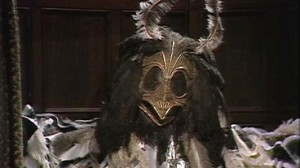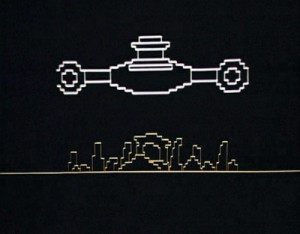 The search for the third segment of the Key to Time leads the Doctor, Romana and K-9 to the Doctor’s favorite planet, Earth, in a story that is a complete opposite from last week’s. While The Pirate Planet featured the Comedy Destroyer of Worlds, The Stones of Blood plays it mostly straight and even attempts a little of the series’ past “Gothic Horror” as our heroes encounter a villain who has no plans to conquer or destroy the world at all, but is just trying to hide.
The search for the third segment of the Key to Time leads the Doctor, Romana and K-9 to the Doctor’s favorite planet, Earth, in a story that is a complete opposite from last week’s. While The Pirate Planet featured the Comedy Destroyer of Worlds, The Stones of Blood plays it mostly straight and even attempts a little of the series’ past “Gothic Horror” as our heroes encounter a villain who has no plans to conquer or destroy the world at all, but is just trying to hide.
The villain in question is an escaped alien criminal, and evidently a near-immortal one, since she’s been hiding out in the same patch of England for the last four thousand years, posing as a series of women owners of an old manor house (and the various more ancient buildings that preceded it). Besides this series of identities, she’s also been playing the role of a Celtic goddess for a small but devoted cult of neo-druids who sacrifice the occasional chicken at a nearby stone circle.
She could probably have gone right on hiding out if she hadn’t been hasty enough to try to kill the Doctor just for asking a few questions. To be fair, if she’s that quick to try and murder someone she thinks is just an archaeologist looking at the stone circle, then she’s probably committed plenty of similar crimes over the centuries to keep her secret, so she’s certainly not innocent and it’s just as well the Doctor puts a stop to it all. But she’s certainly not a world-threatening alien invader.
This is a small-scale story, and that’s a welcome thing after the excesses of last week’s. It does well for two episodes, striking a similar spooky tone as the departed Hinchcliffe/Holmes era (although never quite as dark). The monsters of the story, who serve the main villain as henchmen, are unconvincing even by Classic Who standards but they’re used to as good effect as they can be, and one scene in the third episode when they kill an innocent couple out camping is right up there with Dr Who’s best scary moments. Unfortunately a lot of episode 3 and almost all of episode 4 is devoted to a far-too-long trial scene involving the Doctor, the villain, and the alien “justice machines” sent to apprehend her, which is little more than an excuse for the Tom Baker comedy hour and fails to serve as any kind of exciting climax.
Details
- There’s other stories that could make this point, and I’ll probably revisit it in the future, but it struck me while watching this episode that when the Doctor says the TARDIS has landed “on Earth” or refers to Earth as his favorite planet, he always means Earth in the present day (at the time of the original broadcast). If the TARDIS lands in some other time it’s almost always described by the name of the historical period rather than being called “Earth.” It points out how (paradoxically) Classic Dr Who was almost never about time travel. Different periods in Earth history are treated exactly the same as alien planets, and a question like “why not just use the TARDIS to go back and fix a mistake” is never asked because the TARDIS isn’t really a time machine— it’s a “deliver you to the adventure” machine. Even when the Doctor occasionally moves the TARDIS around in the course of a story, he moves it in space only, until the adventure is over and he goes on to the next one. Classic Who touched on time-travel plotlines now and again but it wasn’t until the new series, and especially Steven Moffat’s era of the new series, that Dr Who started to routinely make time travel into part of its storylines.
- The “stones of blood” of the episode’s title are the “Ogri”, silicon-based life forms that look like standing stones in the prehistoric circle. They feed on blood, and can drain it on contact. As predators, they rely on looking harmless and inert until an unwary victim touches them. It’s a scary enough idea— you lean against what seems like a harmless chunk of rock and it kills you. This is how the Ogri kill the two bystanders in the very scary scene in episode 3: the couple come out of their tent to find that somehow someone’s put two giant stone pillars in the middle of their campsite. As they walk around them, scratching their heads over how such huge stones could have been brought in without their hearing anything, oblivious to the danger they’re in, the suspense is real. You know one or both of them is going to touch one of those rocks, it’s only a question of when.
- The problem with the Ogri comes when they’re called on to move and chase our heroes as good monsters should. They glide along, glowing and making menacing noises, but— they’re just big rocks. Once you know better than to touch them, there’s really nothing they can do. In one scene K-9 pursues one, shooting at it with his nose laser, and the Doctor later finds him badly damaged. “It was too strong,” says K-9. Okay, but— what exactly did it do? Topple on him? The episode has to keep the scene offstage in an attempt to avoid the question.
- And why are silicon-based life forms eating carbon-based blood anyway?
- A better example of Dr Who’s casual attitude toward scientific accuracy comes in a scene between the Doctor and elderly archaeologist Amelia Rumsford. Trying to explain how an alien ship is hidden in hyperspace at the location of the stone circle, the Doctor starts by mentioning Albert Einstein, and we get the following dialog:
Rumsford: I know, Einstein said you can’t go faster than the speed of light because the speed of light is a limiting factor.
Doctor: That’s right, very good. Of course I did try to explain the facts to old Albert, but he would insist that he was right.
Rumsford: Typical, just like a man.
Some SF would spend time on some ponderously serious explanation to get faster-than-light travel into a story while retaining its “hard SF” credentials. Other SF would just plow ahead, ignoring the issue. Here’s Dr Who hitting exactly the right balance, and doing it in a classically Who-ish witty way.
- Where or what is Gallifrey, the home planet of the Time Lords? Is it actually a planet you could find somewhere in space, or is it something else? Over the years the series has dropped hints that there’s something unique about the place besides just being the home of the civilization that invented TARDISes— something perhaps that allowed that civilization to make such an invention. In this episode we get a line that is really just a passing joke, but for lore-obsessed fans, we can add it to the clue list. At one point Rumsford asks the Doctor, “Are you from outer space?” His answer: “No. I’m from what you would call inner time.”
 I may have missed a previous example, but I don’t think so. It think this episode is the first time that Classic Dr Who has employed computer graphics. We’ve seen numbers on computer screens before, and we’ve seen non-computer graphics presented as displays on supposed computer screens, but not actual computer graphics. In this episode, on board the alien spaceship the Doctor calls up a navigational display of the ship’s current position over the stone circle, and gets the graphic shown here. I’m sure it looked very futuristic at the time.
I may have missed a previous example, but I don’t think so. It think this episode is the first time that Classic Dr Who has employed computer graphics. We’ve seen numbers on computer screens before, and we’ve seen non-computer graphics presented as displays on supposed computer screens, but not actual computer graphics. In this episode, on board the alien spaceship the Doctor calls up a navigational display of the ship’s current position over the stone circle, and gets the graphic shown here. I’m sure it looked very futuristic at the time.
Next Week:
“The Androids of Tara,” 4 episodes.

